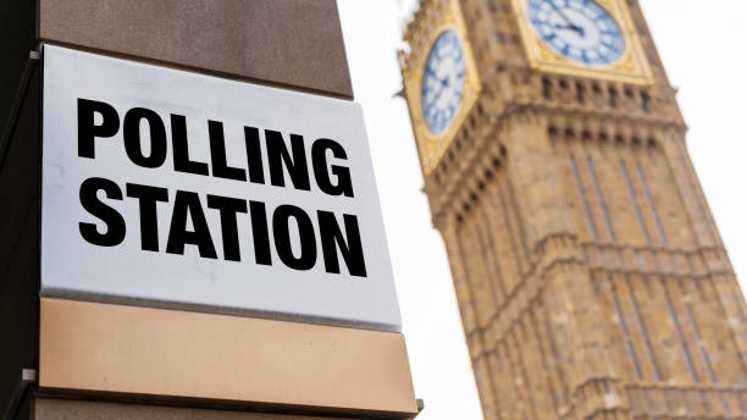Spread bets and CFDs are complex instruments and come with a high risk of losing money rapidly due to leverage. 72% of retail investor accounts lose money when trading spread bets and CFDs with this provider. You should consider whether you understand how spread bets and CFDs work, and whether you can afford to take the high risk of losing your money.
- English (UK)
General Election: Pound Unbothered By Predictable Exit Poll

As mentioned, the exit poll, which has a strong track record of accurately predicting the actual election result, pointed to a Labour majority of 170 seats upon its release, forecasting the following in terms of seats:
- Labour: 410
- Conservative: 131
- Liberal Democrat: 61
- Reform UK: 13
- SNP: 10
Interestingly, such a majority, if it were to be borne out, is a touch narrower than most pollsters had been expecting, while also being narrower than the majority won by Tony Blair in his first electoral victory back in 1997. Nonetheless, such a majority is vast, and convincing.
Unsurprisingly, markets were almost unreactive to the exit poll crossing news wires, as polling stations closed. Cable moved a total of 2 pips once the exit poll was released. This lack of volatility in reaction to the news was largely expected, particularly with overnight implied vols having traded at just 10% on election day, pricing (with a 68% degree of confidence) a move of just +/- 60 pips.
_2024-07-04_22-04-23.jpg)
Of course, immediate focus, throughout the night, will now turn to whether the exit poll proves correct, as results filter in from constituencies around the UK.
The first results should begin to trickle in around 11:30pm BST, with the biggest wave of results set to come between 2:30am BST and 4:30am BST on Friday. By most estimations, Labour will likely have won enough seats for a parliamentary majority by around 3am BST, with the first remarks from PM Sunak, and Labour leader Starmer, due at their respective counts (presuming they each retain their seats) some time after 4am BST. The transfer of power in the UK is lightning fast, with Starmer likely to be Prime Minister by mid-morning, having been asked by the King to form the next Government.
Assuming that the exit poll does bear close resemblance to the overall result – which should become final some time around 6am BST – focus for market participants will likely turn to the below key near-term drivers of UK assets:
- BoE: With the election campaign now over, the monetary policy stasis in place during the election campaign, and MPC speaker blackout, will likely both come to an end. The ‘Old Lady’ seems set to deliver the first 25bp cut of the cycle at the August meeting, providing the June inflation print falls in line with expectations. Beyond that, one further cut is likely before year-end, probably in November, though the GBP OIS curve already discounts a total of 46bp of easing this year
- Budget: A Budget is likely to be unveiled in September, given the timelines involved in the OBR producing fresh forecasts, though fiscal headroom remains severely limited, at around £20bln. Having pledged, during the campaign, not to raise income tax, national insurance, or VAT, it remains to be seen how the proverbial books can be balanced, or whether that aforementioned promise will be broken. In any case, Labour’s ambition for 2.5% annual GDP growth appears punchy, at best, and fanciful, if one were in a less charitable mood
- 1st 100 Days: The first 100 days of a Labour government will see a host of international summits, including a NATO summit in Washington DC, allowing Starmer & Co to set out their vision for how the UK appears on the ‘world stage’. Numerous other key events will also take place, including a King’s Speech setting out the new administration’s legislative agenda; negotiations to attempt to end long-running strike action in numerous sectors, including by junior doctors; as well as policy proposals regarding ‘green’ energy, planning, and asylum seekers
Related articles
The material provided here has not been prepared in accordance with legal requirements designed to promote the independence of investment research and as such is considered to be a marketing communication. Whilst it is not subject to any prohibition on dealing ahead of the dissemination of investment research we will not seek to take any advantage before providing it to our clients.
Pepperstone doesn’t represent that the material provided here is accurate, current or complete, and therefore shouldn’t be relied upon as such. The information, whether from a third party or not, isn’t to be considered as a recommendation; or an offer to buy or sell; or the solicitation of an offer to buy or sell any security, financial product or instrument; or to participate in any particular trading strategy. It does not take into account readers’ financial situation or investment objectives. We advise any readers of this content to seek their own advice. Without the approval of Pepperstone, reproduction or redistribution of this information isn’t permitted.



